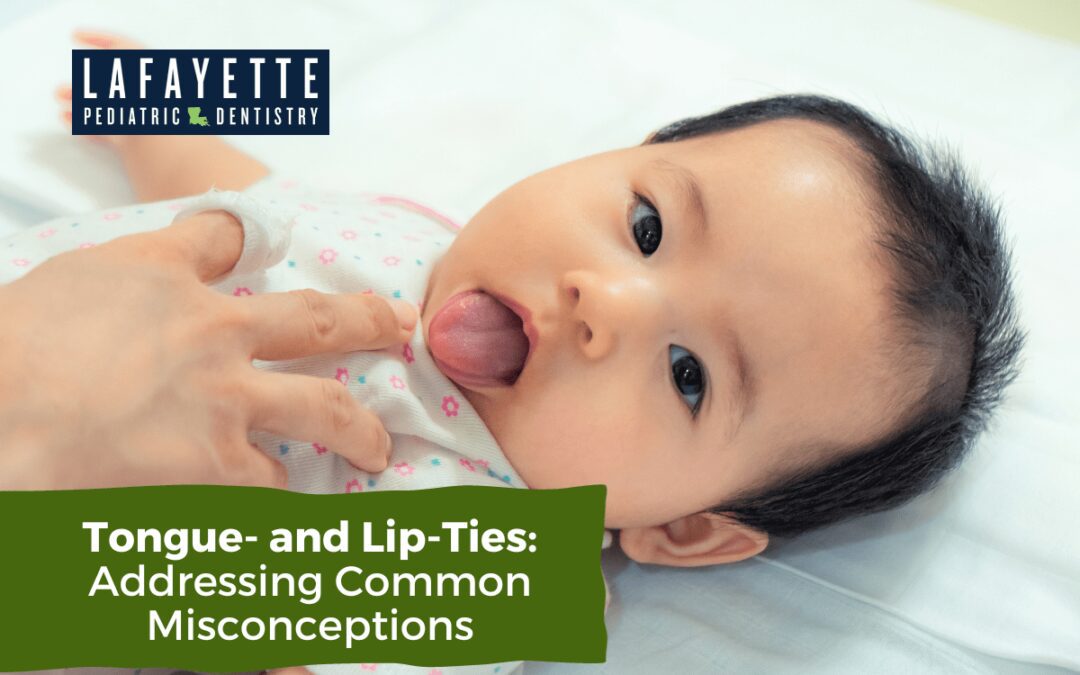For many parents, feeding their baby is far from the beautiful bonding experience they imagined. Their little ones scream in frustration when latching, with milk dribbling down their chin as they seem to swallow more air than milk. Other parents watch their toddlers struggle to eat solids even after reaching the proper age.
While these may seem like isolated issues, they often have one hidden cause in common—abnormally tight or short tissues under the tongue, termed tongue ties. These restricted frenulums can lead to a cascade of short and long-term problems. Lip ties, which are tight tissues attaching the upper lip to the gums, can also complicate feeding.
In this blog, we will delve into the most common misconceptions of tongue- and lip-ties and uncover the truth about these conditions that affect many infants and children.
Cutting the Tie Fixes Everything
One of the biggest misconceptions is that clipping the frenulum is all that is needed to resolve any feeding, speech, or other issues caused by tongue ties. Many believe that the tongue will “automatically” know to move toward the palate as soon as the tie is released. However, this is almost never the case.
The tongue has learned incorrect movement patterns since the baby was 20 weeks old in utero, so even after the tie is fixed, proper therapy is needed to “retrain” the tongue to latch.
Feeding difficulties often persist after the tongue tie is clipped since this does not address the underlying movement pattern issues. Proper therapy after release is essential to help strengthen and re-pattern the tongue’s motions.
Read more: Why Early Feeding, Speech, and Airway Screenings Matter for Your Little One
Tongue Ties Can’t Reattach Once They’re Clipped
Another common misconception is that once a tongue tie is clipped, it’s gone for good. However, the mouth heals incredibly quickly. This means the frenulum can reattach prematurely, causing persistent or recurring mobility issues and symptoms.
After an initial release, vigorous follow-up, stretching, and therapy are required to prevent reattachment. Your pediatric dentist will closely monitor the healing process and be vigilant for any signs of reattachment. If necessary, they may recommend additional revision procedures.
Parents also play a critical preventive role through post-procedure stretches to ensure the tongue can move freely and not revert back to any limitations.
Read more: Why Stretching is Necessary After a Baby’s Frenectomy
Tongue Ties Can Only Affect Feeding During Infancy
Another common myth is that tongue ties only impact feeding and infants. In reality, if not treated properly early on, tongue ties can lead to multiple issues, such as not being able to process table foods, poor tooth alignment or crowding, speech impediments, poor sleep quality, and even sleep apnea later in life.
The abnormal tissue can restrict proper tongue motion, impacting critical functions like swallowing, chewing, and speech development, and as we age, these difficulties get worse if the abnormal frenulum is not addressed.
Many adults suffer from sleep apnea related to undiagnosed ties that cause the tongue to partially obstruct their airway. So, while ties may first become apparent with breastfeeding troubles, the implications can be life-long if left untreated.
Tongue Ties Have Nothing To Do With Colic, Reflux, or Picky Eating
Since restricted tongues affect a baby’s ability to latch and suck properly, many babies compensate by taking in excessive air, gulping milk, or failing to create an adequate oral seal on the breast or bottle. This leads to symptoms that can mimic colic, reflux, and picky eating.
So, your pediatrician may prescribe medications to treat these issues when the real culprit is an undiagnosed tongue tie.
Children Will Grow Out a Tongue Tie
While some minor cases can improve with time, tongue ties rarely “fix themselves” on their own. Oral ties are composed of a type of collagen that does not stretch. Like any other congenital condition, it is best to correct tongue ties as soon as possible to support proper development.
All Lip Ties Need to be Corrected
When it comes to lip ties, many believe that cutting is always the answer. However, the majority of lip ties do not require any intervention. Here are some symptoms to look for that may require a lip tie release:
- Struggling to latch during breast or bottle-feeding
- Difficulty sealing lips together
- The lip tie interferes with brushing the upper front teeth or the positioning of the teeth.
One sign that typically does NOT warrant treatment is a gap between the front teeth caused by a lip tie. Many assume this gap means the lip tie must be cut. However, for most children, the gap naturally closes as their permanent teeth emerge. And that space is actually helpful to hold a spot for permanent teeth.
Read Also: Tongue-Tie in Infants and Young Children: Signs to Look Out For
If your child is showing signs such as difficulty breastfeeding, gassiness or excessive spit-up, a heart-shaped tongue, limited tongue mobility, and sensitivity to certain food textures, don’t wait to take action. These feeding problems are often tied to untreated tongue- or lip ties.
They won’t simply resolve on their own and can lead to long-term struggles with speaking, eating, and oral health if not properly addressed.
Dr. Anita Gouri is proud to be one of Lafayette’s preferred experts in assessing and treating tongue and lip-ties. We understand this is uncharted territory for many families. That’s why we’re happy to answer any questions you may have and provide the caring, personalized guidance you and your child deserve.
Fill out our online form or give us a call to schedule a comprehensive evaluation. We’ll determine if your child has a tongue- or lip tie and walk you through the best treatment options, including our laser release procedures and necessary therapies. Be their advocate, we’re here to assist you.
